How to Realize the Integration of Urbanization and Rural Village Renewal Strategies in Rural Areas: The Case Study of Laizhou, China
Abstract
1. Introduction
2. Theoretical Framework and Methodology
2.1. Theoretical Framework
2.2. Methodology
2.2.1. Rural Adaptive Capacity Assessment for Urbanization and Village Renewal
The RUS Evaluation System
The VRP Evaluation System
Static Comprehensive Evaluation Method
2.2.2. Spatial Interaction Calculation and Network Construction
Gravity Model
Social Network Analysis (SNA)
2.2.3. Village Cluster Identification
3. Study Area and Datasets
3.1. Study Area
3.2. Data Sources
4. Results and Discussion
4.1. Characteristics of the Individual Village
4.1.1. Evaluation of RUS in Laizhou
4.1.2. Evaluation for VRP in Laizhou
4.2. Spatial Interaction between Villages
4.3. Village Cluster
4.4. Discussion
- (1)
- The super large clusters in Laizhou are Clusters 1, 2, and 52 marked in Figure 7. The area of these three clusters accounts for 31.64% of the total area. Cluster 1 is composed of 122 villages, of which 75 have relative advantages in rural urbanization, i.e., the RUS index is high. This cluster is located in Laizhou city and the surrounding area and is a cluster with urbanization as the core driving force. Cluster 2 has 102 villages, of which 90 are relatively advantageous in rural vitalization. The VRP index is high. This cluster is located in the plain area in the central part of Laizhou, in the transition zone between the western coastal area and the eastern mountainous area, which is the main agricultural production area. The development of this group is based on modern agriculture, focusing on the development of ecological agriculture and the agricultural mechanization industry. Cluster 52 has 189 villages, of which 165 villages are relatively advantageous in rural vitalization. It is located in southwestern Laizhou, which is an industrial agglomeration area, forming the building materials industry known as the “stone capital of China”, the gold industry, and the energy chemical industry. According to the above analysis, super-large clusters mainly rely on industrial advantages, so industrial transformation and upgrading are fundamental driving forces promoting the development of villages.
- (2)
- The large groups are numbered 3, 5, 78, and 79 in Figure 7, which contain 44 villages on average, and the area of these four groups accounts for 31.64% of the total area. Some clusters have a dominant development direction, while others do not. Clusters 3 and 5 are the former and have rural vitalization as an advantage. Cluster 3 is located in southern Laizhou and is mainly for agricultural production and seedling planting. For example, Dongdasong village implemented the “Rose town” project in the form of rural cooperatives, cultivating more than 360 rose varieties, with a planting area of 607 ha, forming a close network with surrounding villages. Group 5 is located in the northern coastal area of Laizhou and mainly focuses on coastal tourism and port services. On the other hand, Clusters 78 and 79 have no dominant development direction, and the RUS and VRP are both low. These two clusters are located in the southeast mountainous area, which is an important ecological space of Laizhou, so development is limited. In total, large groups with advantageous development directions mainly rely on the project. However, compared with the super large-scale cluster, the number of villages in the large cluster is small, which indicates that the driving force of the project is insufficient. The large group with no dominant development direction is mainly subject to strict environmental constraints, and the breakthrough point of this group may be green ecological agriculture and rural tourism.
- (3)
- There are 12 middle groups, accounting for 18.11% of the total area. Among them, 10 clusters have dominant development directions, while 2 clusters have no direction. Laizhou adopts the mode of “company + farmer + bases” to develop rural industries, which plays an important role in driving the spatial interaction between villages. In general, the middle group of Laizhou is mainly driven by the advantages of scenic spots and brand agricultural products and planting bases. For example, Group 4 mainly relies on the “Great Wall of Water” of Hutou Cliff, while Group 62 mainly relies on the “10000 mu grape base” project of China’s largest wine producer (named Changyu Wine Company). The middle groups, without a development advantage, are Groups 53 and 101, which are distributed in the southern mountainous area and the eastern edge of Laizhou.
- (4)
- The number of small groups is 28, accounting for 21.05% of the total area, mainly distributed in northeastern Laizhou and the central urban–rural ecotone. Among them, 12 subgroups have a dominant development direction and 7 do not. The number of small groups with advantages in village renewal is 75%, mainly relying on local farmers’ professional cooperatives and agricultural production bases. For example, Pinglidian town has built an “Internet+” smart agricultural town, selling ginger, strawberries, and other characteristic industries through the network platform. The small groups in the urban–rural transition zone often have advantages in rural urbanization. Their development mainly relies on the radiation of the main urban area, and they have advantages in the construction of industrial parks and the reconstruction of rural industries. The small group without advantages in Laizhou is the spatial agglomeration of villages with poor rural development, which is an important area for rural spatial management.
- (5)
- The 86 villages excluding the cluster are scattered in Laizhou, and the relatively concentrated areas are mainly on the northeast and southwest coasts of Laizhou. These isolated villages have the following three situations: First, their own RUS and VRP are low, while the surrounding areas are strong, accounting for approximately 47.37%. Second, their own RUS is high, but the surrounding areas have advantages in VRP, accounting for approximately 38.95%. Third, their own VRP is high, but the surrounding areas have advantages in RUS, accounting for approximately 11.58%. The possible reason for the isolation of these villages is that the development mode of these villages is different from that of the surrounding villages, which leads to weak spatial interaction, thus not forming a village cluster.
5. Policy Implications and Conclusions
5.1. Policy Implications
5.2. Conclusions
Author Contributions
Funding
Data Availability Statement
Conflicts of Interest
Appendix A. The Data in Laizhou
| No. | First-Level Classification | Quantity | Proportion |
|---|---|---|---|
| 1 | public facilities | 900 | 2.78% |
| 2 | Institutional unit | 1381 | 4.26% |
| 3 | educational institution | 1105 | 3.41% |
| 4 | tourist attraction | 95 | 0.29% |
| 5 | enterprise | 3802 | 11.74% |
| 6 | Life service place | 6144 | 18.97% |
| 7 | Entertainment places | 12,970 | 40.04% |
| 8 | Residential | 788 | 2.43% |
| 9 | others | 5207 | 16.07% |
| In total | 32,392 | 100.00% | |
| Number | Towns | Villages | Types of Villages | Ties | Pairs | Density | |||
|---|---|---|---|---|---|---|---|---|---|
| HH | HL | LH | LL | ||||||
| 1 | 9 | 122 | 74 | 1 | 43 | 4 | 3238 | 10,368 | 31.55 |
| 2 | 5 | 102 | 14 | 1 | 76 | 11 | 2203 | 7543 | 29.24 |
| 3 | 5 | 61 | 12 | 37 | 12 | 1919 | 5950 | 31.99 | |
| 4 | 3 | 20 | 8 | 12 | 2383 | 7441 | 33.28 | ||
| 5 | 3 | 50 | 17 | 33 | 1193 | 3833 | 33.05 | ||
| 6 | 2 | 5 | 5 | 1865 | 6323 | 29.88 | |||
| 7 | 3 | 9 | 7 | 2 | 2835 | 9800 | 28.85 | ||
| 8 | 3 | 5 | 5 | 2172 | 7063 | 31.03 | |||
| 12 | 3 | 13 | 2 | 10 | 1 | 950 | 2850 | 34.38 | |
| 17 | 1 | 6 | 6 | 1405 | 4270 | 34.30 | |||
| 18 | 2 | 18 | 9 | 9 | 2344 | 7941 | 29.57 | ||
| 19 | 1 | 5 | 3 | 2 | 1262 | 3932 | 32.32 | ||
| 22 | 2 | 5 | 5 | 3649 | 12,526 | 29.17 | |||
| 23 | 2 | 5 | 5 | 3505 | 11,953 | 29.33 | |||
| 24 | 2 | 3 | 3 | 4011 | 12,891 | 30.99 | |||
| 32 | 2 | 5 | 5 | 3382 | 11,910 | 28.29 | |||
| 52 | 5 | 189 | 77 | 7 | 88 | 17 | 2751 | 8618 | 33.03 |
| 53 | 2 | 13 | 5 | 8 | 899 | 2376 | 40.69 | ||
| 56 | 2 | 3 | 1 | 2 | 3191 | 10,857 | 29.44 | ||
| 57 | 2 | 20 | 3 | 15 | 2 | 2262 | 7198 | 31.99 | |
| 58 | 2 | 11 | 2 | 9 | 1752 | 5521 | 33.18 | ||
| 60 | 2 | 11 | 11 | 2896 | 9677 | 29.95 | |||
| 61 | 2 | 3 | 1 | 2 | 1933 | 6181 | 32.42 | ||
| 62 | 2 | 18 | 9 | 9 | 2095 | 6589 | 32.47 | ||
| 63 | 2 | 16 | 2 | 13 | 1 | 2656 | 8854 | 30.10 | |
| 64 | 2 | 10 | 1 | 9 | 1738 | 5352 | 33.64 | ||
| 65 | 2 | 4 | 4 | 3177 | 10,510 | 30.22 | |||
| 66 | 1 | 3 | 2 | 1 | 2551 | 8307 | 31.97 | ||
| 73 | 2 | 3 | 3 | 2978 | 9914 | 30.02 | |||
| 75 | 3 | 4 | 3 | 1 | 2945 | 9671 | 30.52 | ||
| 78 | 1 | 41 | 3 | 2 | 16 | 20 | 648 | 2075 | 32.41 |
| 79 | 1 | 24 | 4 | 4 | 16 | 508 | 1504 | 35.03 | |
| 80 | 1 | 7 | 7 | 263 | 852 | 31.70 | |||
| 81 | 2 | 3 | 3 | 798 | 2881 | 27.52 | |||
| 83 | 1 | 17 | 10 | 1 | 5 | 1 | 684 | 1817 | 40.06 |
| 84 | 1 | 3 | 3 | 1315 | 3889 | 33.80 | |||
| 90 | 1 | 7 | 3 | 4 | 2571 | 8722 | 29.49 | ||
| 97 | 2 | 4 | 3 | 1 | 2713 | 9006 | 30.38 | ||
| 98 | 1 | 10 | 2 | 1 | 7 | 1314 | 4465 | 29.23 | |
| 101 | 1 | 13 | 4 | 9 | 1079 | 3274 | 32.89 | ||
| 102 | 1 | 8 | 8 | 813 | 2072 | 40.11 | |||
| 103 | 1 | 3 | 3 | 1216 | 3389 | 37.92 | |||
| 114 | 2 | 3 | 2 | 1 | 2107 | 6811 | 30.98 | ||
| 120 | 3 | 9 | 4 | 5 | 2810 | 9340 | 30.77 | ||
| 122 | 1 | 5 | 3 | 2 | 430 | 1313 | 33.17 | ||
| 126 | 1 | 16 | 8 | 8 | 979 | 2611 | 38.96 | ||
| 131 | 1 | 4 | 4 | 10 | 23 | 45.83 | |||
References
- Biczkowski, M. LEADER as a mechanism of neo-endogenous development of rural areas: The case of Poland. Misc. Geogr. 2020, 24, 232–244. [Google Scholar] [CrossRef]
- Sulistyorini, A. From urbanization to ruralization. Monas J. Inov. Apar. 2020, 2, 145–162. [Google Scholar] [CrossRef]
- Mack, G.; Fîntîneru, G.; Kohler, A. Do rural development measures improve vitality of rural areas in Romania. AgroLife Sci. J. 2018, 7, 82–98. [Google Scholar]
- Makkonen, T.; Kahila, P. Vitality policy as a tool for rural development in peripheral Finland. Growth Chang. 2021, 52, 706–726. [Google Scholar] [CrossRef]
- De Janvry, A.; Sadoulet, E.; Murgai, R. Rural development and rural policy. Handb. Agric. Econ. 2002, 2, 1593–1658. [Google Scholar]
- Brauer, R.; Dymitrow, M. Quality of life in rural areas: A topic for the Rural Development policy? Bull. Geography. Socio-Econ. Ser. 2014, 25, 25–54. [Google Scholar] [CrossRef]
- Mikulcak, F.; Haider, J.L.; Abson, D.J.; Newig, J.; Fischer, J. Applying a capitals approach to understand rural development traps: A case study from post-socialist Romania. Land Use Policy. 2015, 43, 248–258. [Google Scholar] [CrossRef]
- Fielding, A.J. Migration and urbanization in Western Europe since 1950. Geogr. J. 1989, 155, 60–69. [Google Scholar] [CrossRef]
- Eng, I. The rise of manufacturing towns: Externally driven industrialization and urban development in the Pearl River Delta of China. Int. J. Urban Reg. Res. 1997, 21, 554–568. [Google Scholar] [CrossRef]
- Claval, P. European rural societies and landscapes, and the challenge of urbanization and industrialization in the nineteenth and twentieth centuries. Geogr. Ann. Ser. B Hum. Geogr. 1988, 70, 27–38. [Google Scholar] [CrossRef]
- Song, H.; Thisse, J.F.; Zhu, X. Urbanization and/or rural industrialization in China. Reg. Sci. Urban Econ. 2012, 42, 126–134. [Google Scholar] [CrossRef]
- Ray, C. Towards a meta-framework of endogenous development: Repertoires, paths, democracy and rights. Sociol. Rural. 1999, 39, 522–537. [Google Scholar] [CrossRef]
- Margarian, A. A constructive critique of the endogenous development approach in the European support of rural areas. Growth Chang. 2013, 44, 1–29. [Google Scholar] [CrossRef]
- Baumert, S.; Fisher, J.; Ryan, C.; Woollen, E.; Vollmer, F.; Artur, L.; Zorrilla-Miras, P.; Mahamane, M. Forgone opportunities of large-scale agricultural investment: A comparison of three models of soya production in Central Mozambique. World Dev. Perspect. 2019, 16, 100145. [Google Scholar] [CrossRef]
- Aryeetey, E. Decentralization for rural development: Exogenous factors and semi-autonomous programme units in Ghana. Community Dev. J. 1990, 25, 206–214. [Google Scholar] [CrossRef]
- Kumar, R. Allocation of Subsidies and Their Impact on Rural Development: A Micro Level Study; IIT Delhi: Delhi, India, 1990. [Google Scholar]
- Ray, C. Endogenous development in the era of reflexive modernity. J. Rural. Stud. 1999, 15, 257–267. [Google Scholar] [CrossRef]
- Jenkins, T.N. Putting postmodernity into practice: Endogenous development and the role of traditional cultures in the rural development of marginal regions. Ecol. Econ. 2000, 34, 301–313. [Google Scholar] [CrossRef]
- Chen, Y.; Tan, Y.; Gruschke, A. Rural vulnerability, migration, and relocation in mountain areas of Western China: An overview of key issues and policy interventions. Chin. J. Popul. Resour. Environ. 2021, 19, 110–116. [Google Scholar] [CrossRef]
- Li, X.F.; Liu, J.Q.; Jia, J.; Yang, H. Relationship between multifunctionality and rural sustainable development: Insights from 129 counties of the Sichuan Province, China. Chin. J. Popul. Resour. Environ. 2022, 20, 285–294. [Google Scholar] [CrossRef]
- Shen, J. Rural development and rural to urban migration in China 1978–1990. Geoforum 1995, 26, 395–409. [Google Scholar] [CrossRef]
- Chen, W. Politics and paths of rural development in China: The village conglomerate in Shandong Province. Pac. Aff. 1998, 71, 25–39. [Google Scholar] [CrossRef]
- Zhu, Y. In situ urbanization in rural China: Case studies from Fujian Province. Dev. Chang. 2000, 31, 413–434. [Google Scholar] [CrossRef]
- Wang, X.R.; Hui, E.C.M.; Choguill, C.; Jia, S.H. The new urbanization policy in China: Which way forward? Habitat Int. 2015, 47, 279–284. [Google Scholar] [CrossRef]
- Liu, Y.; Zang, Y.; Yang, Y. China’s rural revitalization and development: Theory, technology and management. J. Geogr. Sci. 2020, 30, 1923–1942. [Google Scholar] [CrossRef]
- Chen, M.; Zhou, Y.; Huang, X.; Ye, C. The integration of new-type urbanization and rural revitalization strategies in China: Origin, reality and future trends. Land 2021, 10, 207. [Google Scholar] [CrossRef]
- Chigbu, U.E. Village renewal as an instrument of rural development: Evidence from Weyarn, Germany. Community Dev. 2012, 43, 209–224. [Google Scholar] [CrossRef]
- Dwyer, J.; Ward, N.; Lowe, P.; Baldock, D. European rural development under the Common Agricultural Policy’s ‘Second Pillar’: Institutional conservatism and innovation. Reg. Stud. 2007, 41, 873–888. [Google Scholar] [CrossRef]
- Beddows, S.; Dall’Osto, M.; Harrison, M. Cluster Analysis of Rural, Urban, and Curbside Atmospheric Particle Size Data. Environ. Sci. Technol. 2009, 43, 4694–4700. [Google Scholar] [CrossRef]
- Saah, D.; Patterson, T.; Buchholz, T.; Ganz, D.; Albert, D.; Rush, K. Modeling economic and carbon consequences of a shift to wood-based energy in a rural ’cluster’; a network analysis in southeast Alaska. Ecol. Econ. 2014, 107, 287–298. [Google Scholar] [CrossRef]
- Van Der Ploeg, J.D.; Marsden, T. Unfolding Webs: The Dynamics of Regional Rural Development; Royal van Gorcum: Assen, The Netherlands, 2008. [Google Scholar]
- Wilson, R.; Din, A. Calculating varying scales of clustering among locations. Cityscape 2018, 20, 215–232. [Google Scholar]
- Cloke, P.J. Changing patterns of urbanisation in rural areas of England and Wales, 1961–1971. Reg. Stud. 1978, 12, 603–617. [Google Scholar] [CrossRef]
- Li, Y.; Fan, P.; Liu, Y. What makes better village development in traditional agricultural areas of China? Evidence from long-term observation of typical villages. Habitat Int. 2019, 83, 111–124. [Google Scholar] [CrossRef]
- Zhu, Y.; Wang, W.W.; Lin, L.; Shen, J.; Ren, Q. Return migration and in situ urbanization of migrant sending areas: Insights from a survey of seven provinces in China. Cities 2021, 115, 103242. [Google Scholar] [CrossRef]
- Xia, X.; Lin, K.; Ding, Y.; Dong, X.; Sun, H.; Hu, B. Research on the Coupling Coordination Relationships between Urban Function Mixing Degree and Urbanization Development Level Based on Information Entropy. Int. J. Environ. Res. Public Health 2021, 18, 242. [Google Scholar] [CrossRef]
- Ha, I.; Grunwell, S.S. The economic impact of a heritage tourism attraction on a rural economy: The Great Smoky Mountains Railroad. Tour. Anal. 2011, 16, 629–636. [Google Scholar] [CrossRef]
- Ge, D.; Zhou, G.; Qiao, W.; Yang, M. Land use transition and rural spatial governance: Mechanism, framework and perspectives. J. Geogr. Sci. 2020, 30, 1325–1340. [Google Scholar] [CrossRef]
- Xie, Z.; Zhang, F.; Lun, F.; Gao, Y.; Ao, J.; Zhou, J. Research on a diagnostic system of rural vitalization based on development elements in China. Land Use Policy 2020, 92, 104421. [Google Scholar] [CrossRef]
- Liebowitz, J. Linking social network analysis with the analytic hierarchy process for knowledge mapping in organizations. J. Knowl. Manag. 2005, 9, 76–86. [Google Scholar] [CrossRef]
- Everett, M.; Borgatti, S.P. Ego network betweenness. Soc. Netw. 2005, 27, 31–38. [Google Scholar] [CrossRef]
- Enright, A.J.; Van Dongen, S.; Ouzounis, C.A. An efficient algorithm for large-scale detection of protein families. Nucleic Acids Res. 2002, 30, 1575–1584. [Google Scholar] [CrossRef]
- Zhang, L.; Ren, Z.; Chen, B.; Gong, P.; Fu, H.; Xu, B. A Prolonged Artificial Nighttime-light Dataset of China (1984–2020). National Tibetan Plateau Data Center. Natl. Tibet. Plateau Data Cent. 2021. [Google Scholar] [CrossRef]
- Ryan, R.L. Comparing the attitudes of local residents, planners, and developers about preserving rural character in New England. Landsc. Urban Plan. 2006, 75, 5–22. [Google Scholar] [CrossRef]
- Douglass, M. A regional network strategy for reciprocal rural–urban linkages: An agenda for policy research with reference to Indonesia. In The Earthscan Reader in Rural–Urban Linkages; Routledge: London, UK, 2018; pp. 124–154. [Google Scholar]
- Ye, C.; Liu, Z. Rural-urban co-governance: Multi-scale practice. Sci. Bull. 2020, 65, 778–780. [Google Scholar] [CrossRef]
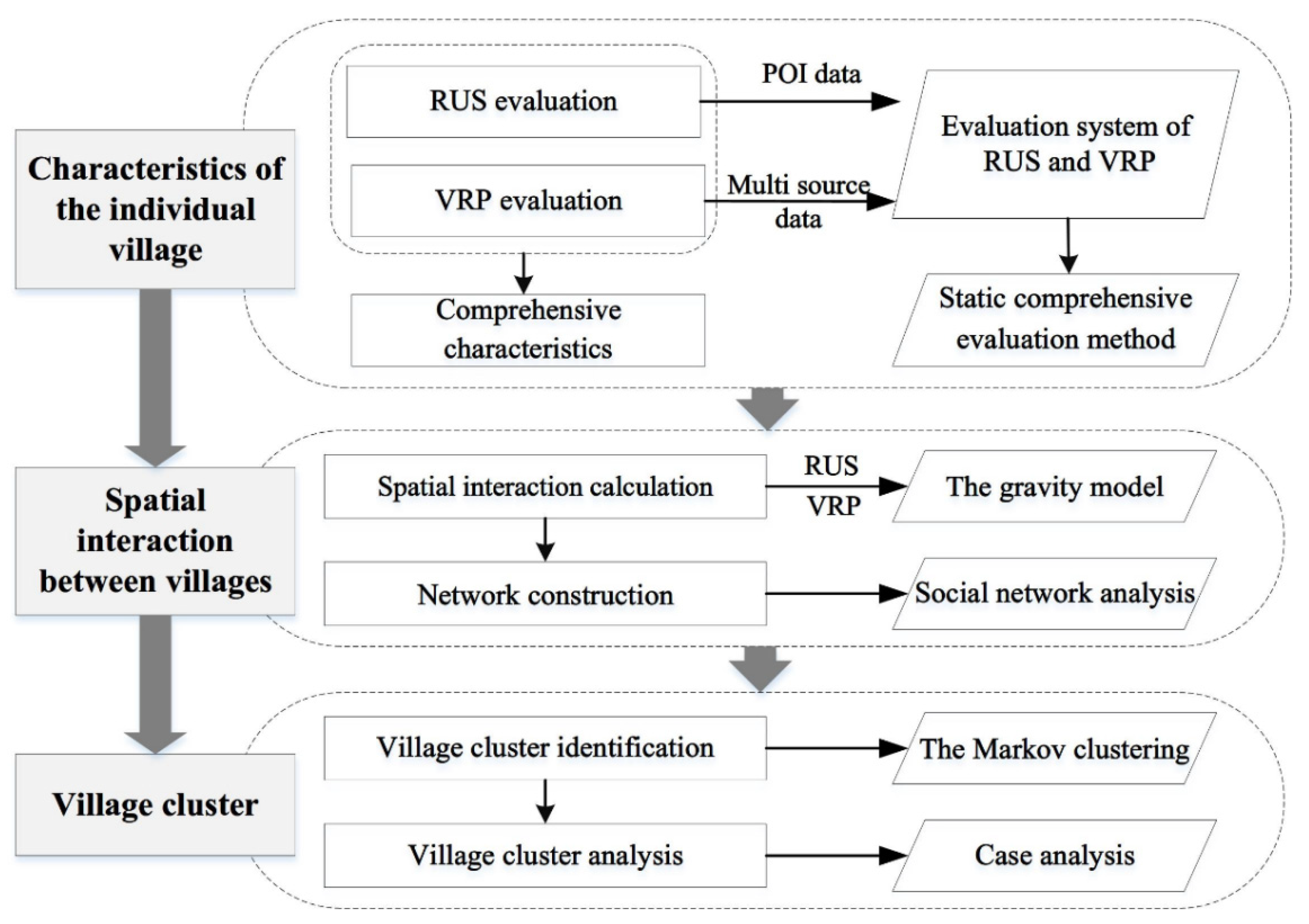
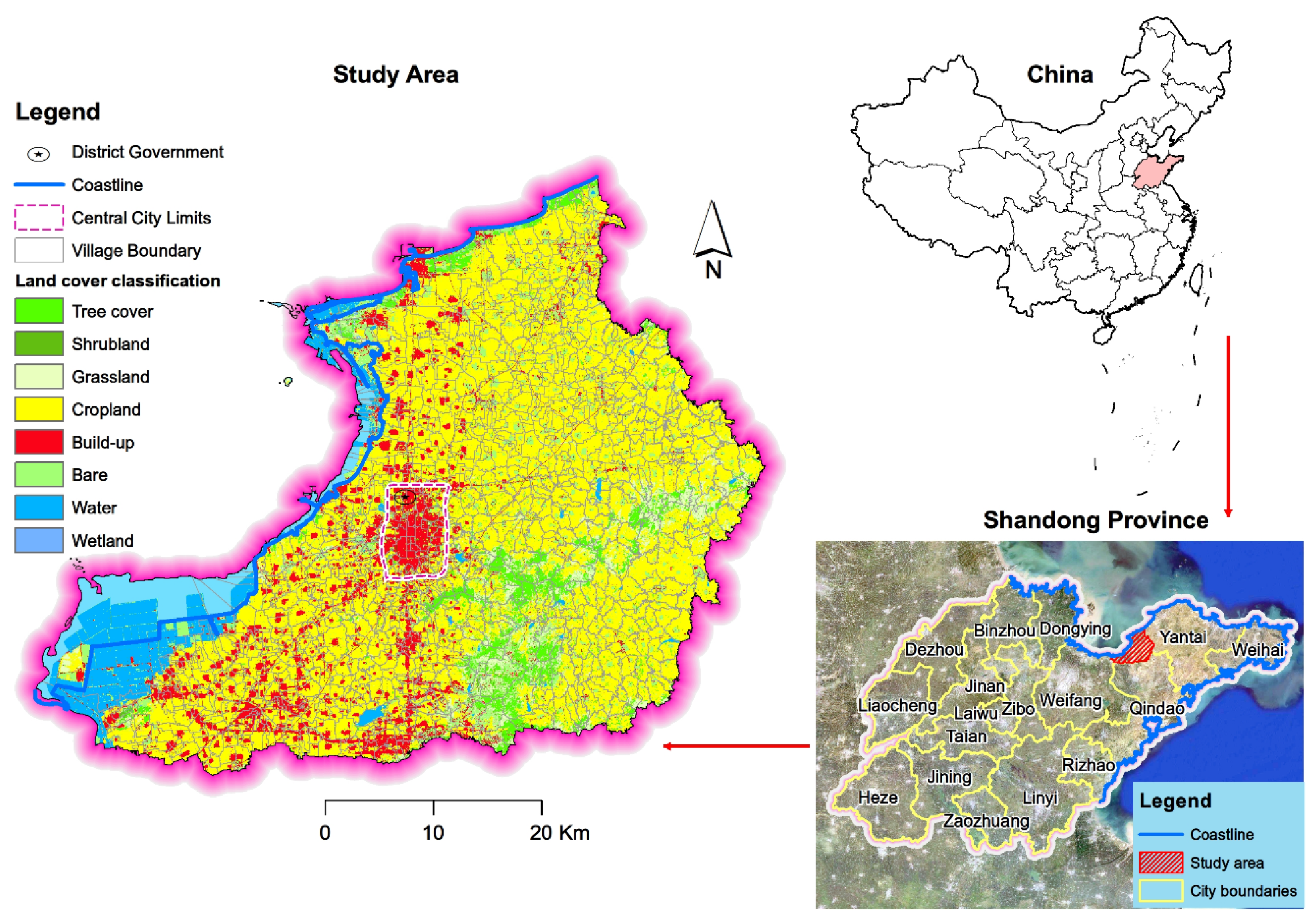

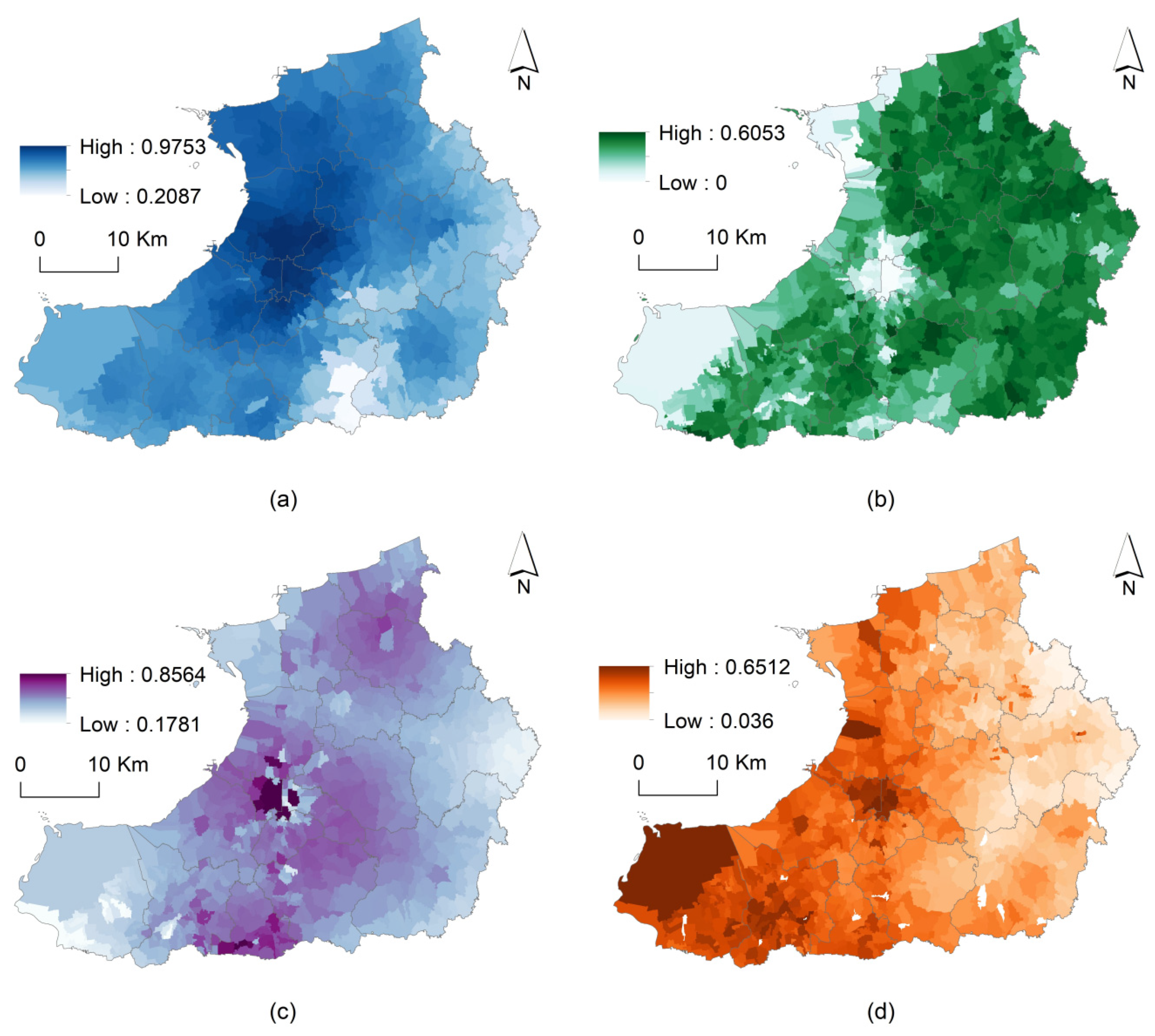
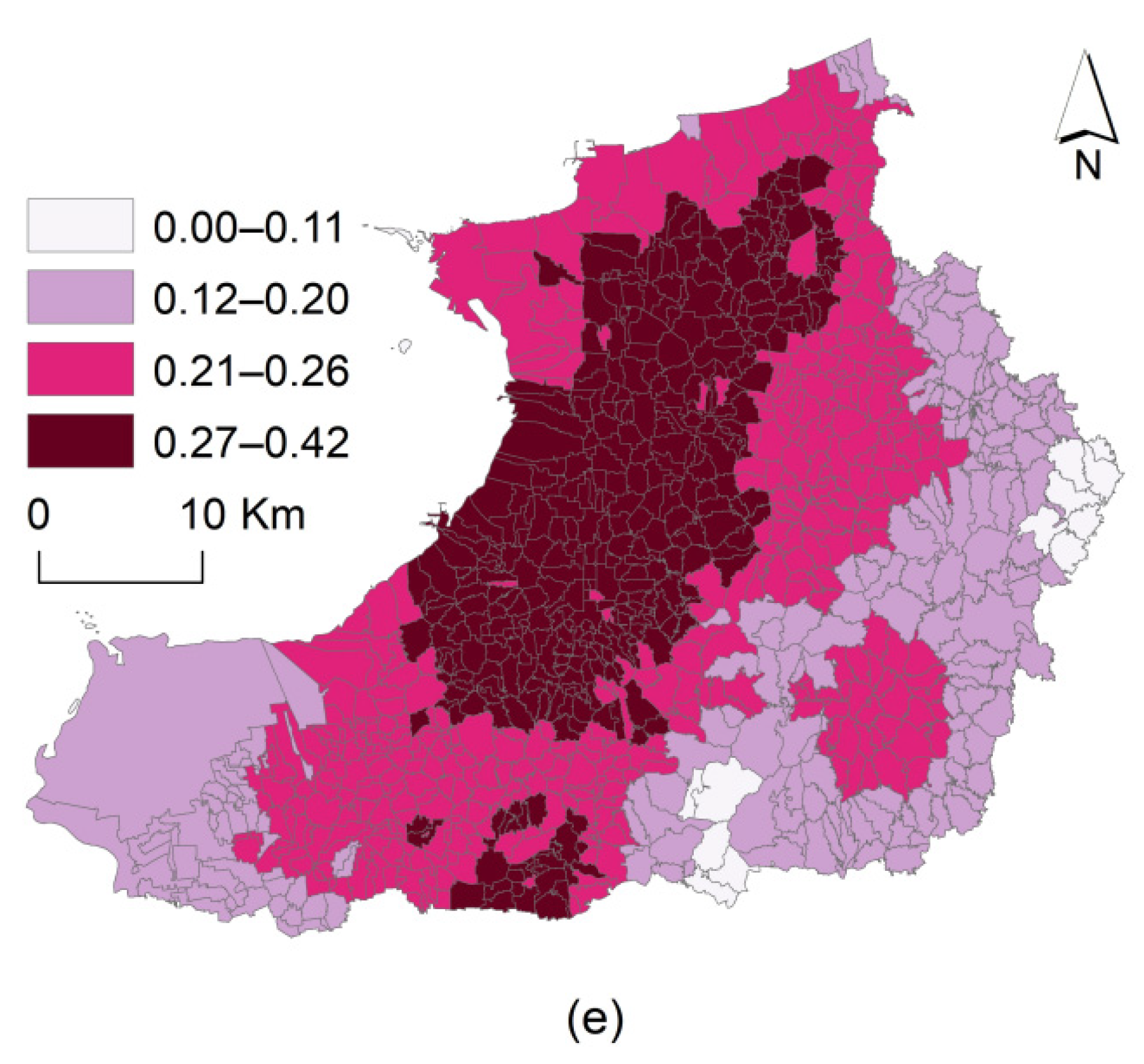
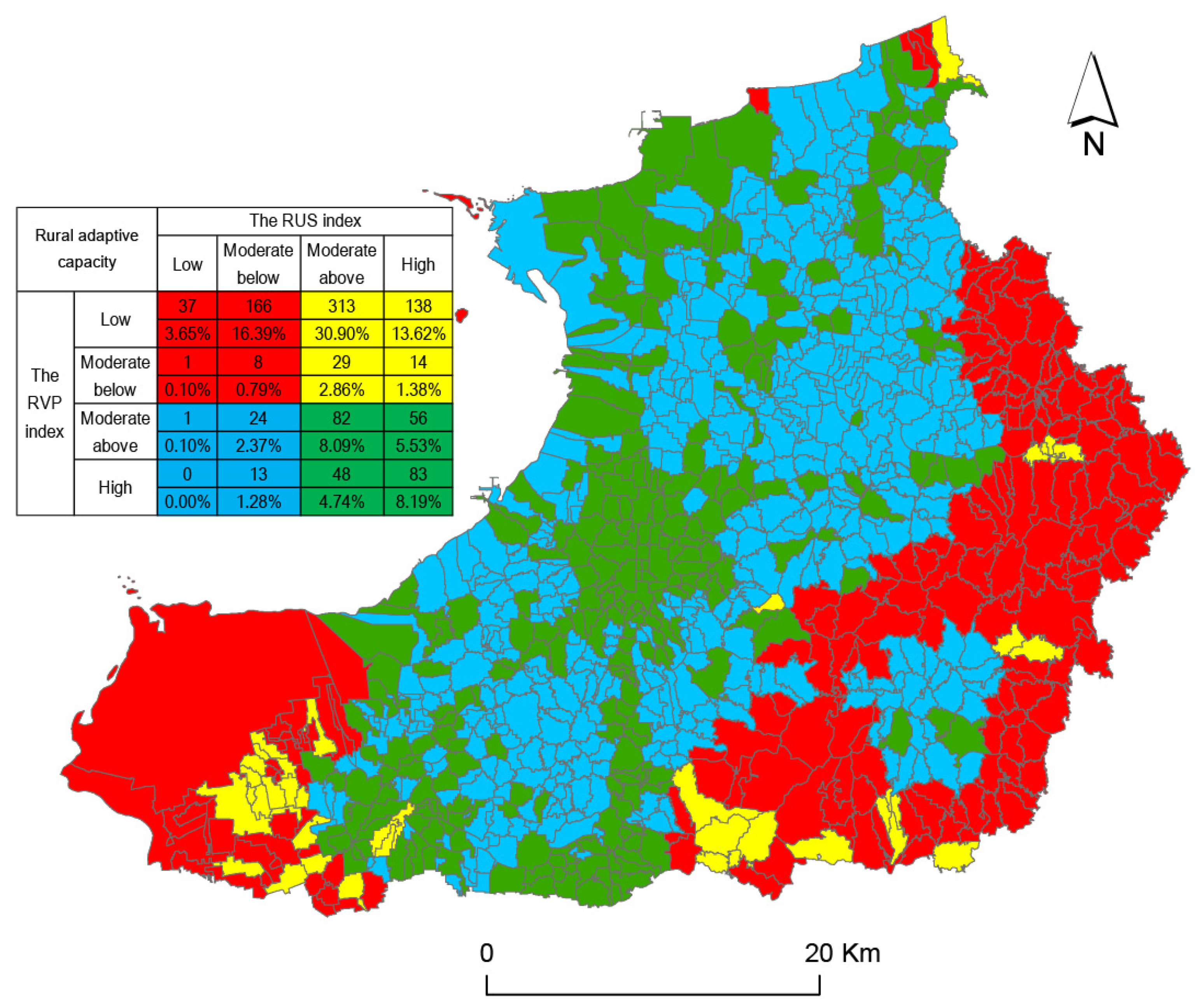
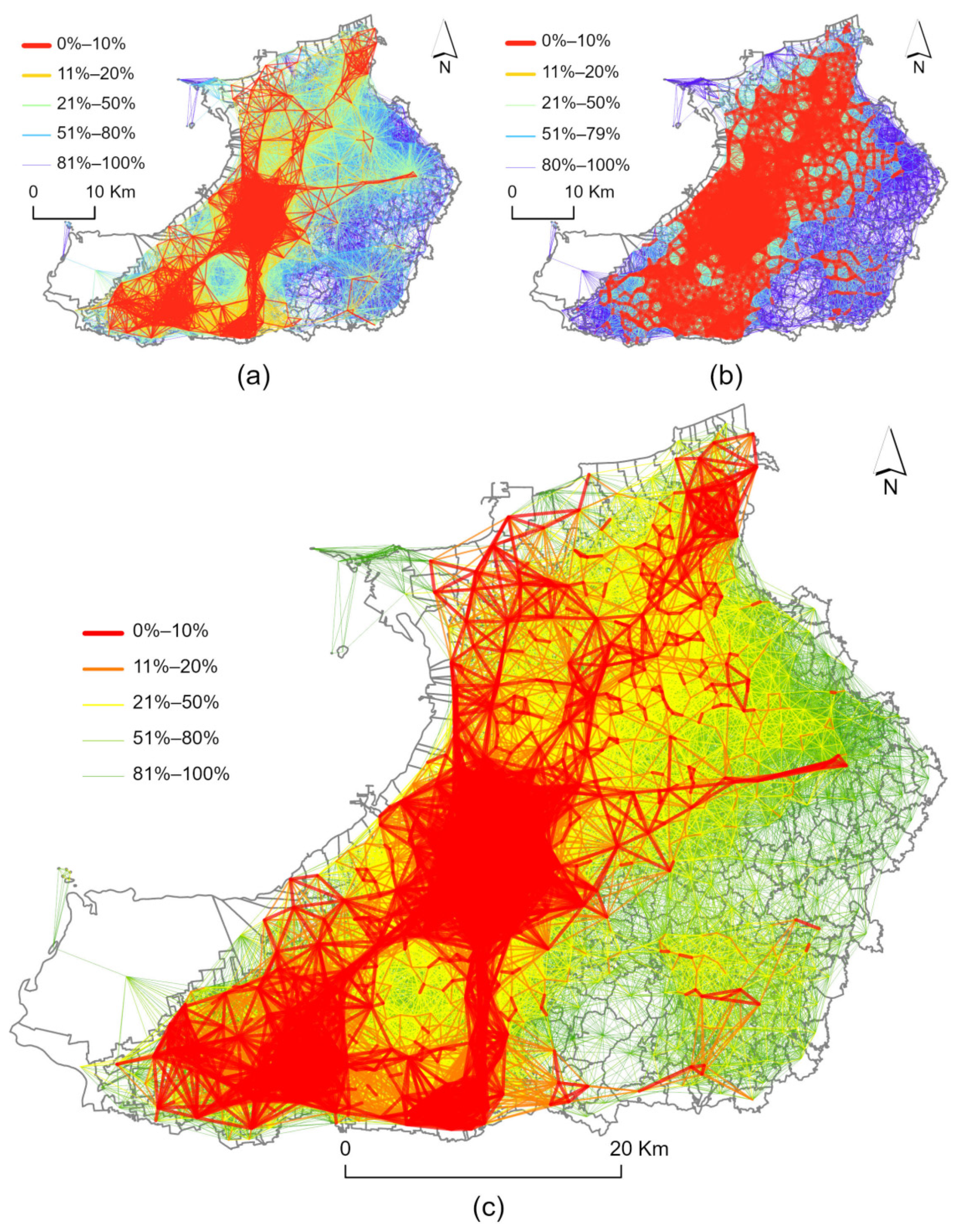

| First-Level Classification | Second-Level Classification | Weights |
|---|---|---|
| Public facilities | Bus station, railway station, parking lot, port terminal, public toilet, etc. | 0.1268 |
| Institutional unit | Government agencies, social organizations, public security, industrial and commercial taxation, industry associations, etc. | 0.1595 |
| Educational institution | Science, education and cultural venues, museums, media institutions, schools, scientific research institutions, etc. | 0.1489 |
| Tourist attraction | Parks, squares, scenic spots, bays and straits, religious temples, etc. | 0.1277 |
| Enterprise | Production bases, factories, industrial parks, warehousing, banking, etc. | 0.1383 |
| Life service place | Auto repair shops, communication services, logistics, health care services, etc. | 0.0885 |
| Entertainment places | Dining venues, shopping venues, sports venues, entertainment venues, leisure venues, holiday convalescence venues, etc. | 0.1108 |
| Residential | Apartments, villas, community centers, etc. | 0.0996 |
| First-Class Index | Second-Class Index | Third-Class Index | Explaining | Weights |
|---|---|---|---|---|
| Geographic location | Location | R1 Average distance to the county *# | It is calculated in grid units and then counted to the village | 0.0613 |
| R2 Average distance to township government *# | It is calculated in grid units and then counted to the village | 0.0494 | ||
| Transportation | R3 Average distance to traffic trunk line *# | It is calculated in grid units and then counted to the village | 0.0392 | |
| R4 Density of roads in the village | Total length of all roads in the village/total area of the village | 0.0198 | ||
| Resource endowment | Production resources | R5 Proportion of cultivated land area | Cultivated land area/total area of village | 0.0432 |
| R6 Proportion of garden area | garden land area/total area of village | 0.0425 | ||
| R7 Proportion of forestland area | Forestland area/total area of village | 0.0410 | ||
| R8 Proportion of industrial and mining land area | Industrial and mining land area/total area of village | 0.0486 | ||
| Ecological resources | R9 Proportion of ecological land area | Ecological land area/total area of village | 0.0424 | |
| R10 Number of tourist attractions (above A-Level) | POI data statistics | 0.0384 | ||
| Economic circumstance | Economic background | R11 GDP per unit area | GDP/total area of village | 0.0381 |
| R12 Urbanization rate in rural area | Urban construction land area/total area of village | 0.0278 | ||
| Industrial foundation | R13 Proportion of Commercial land area | Commercial land area/total area of village | 0.0607 | |
| R14 Number of village and township enterprises | POI data statistics | 0.0580 | ||
| R15 Number of entertainment and leisure venues | POI data statistics | 0.0252 | ||
| Social condition | Village scale | R16 Population size | Population density of the village× total area of village | 0.0578 |
| R17 Scale of rural settlements | The land survey data are used and the data of land plots is summed up | 0.0575 | ||
| R18 Vacancy in rural residential areas * | Converted to the plot according to the annual average night light brightness data | 0.0664 | ||
| R19 Per capita construction land | Urban construction land area/population | 0.0396 | ||
| Public services | R20 Average distance to medical institution *# | It is calculated in grid units and then counted to the village | 0.0476 | |
| R21 Average distance to primary and secondary schools *# | It is calculated in grid units and then counted to the village | 0.0453 |
| Network Description | Indicators | Measurement |
|---|---|---|
| Scale | Nods | The number of points in the network, expressed by n |
| Ties | The number of edges in the network, expressed by m | |
| Closeness | Density | The actual number of ties is divided by the maximum possible number of ties, and it can be calculated by m/[n (n − 1)] in the directed network |
| Average distance (AD) | The distance between two nodes is defined as the number of edges along the shortest path connecting them, and AD is the average distance between all pairs of nodes. |
Publisher’s Note: MDPI stays neutral with regard to jurisdictional claims in published maps and institutional affiliations. |
© 2022 by the authors. Licensee MDPI, Basel, Switzerland. This article is an open access article distributed under the terms and conditions of the Creative Commons Attribution (CC BY) license (https://creativecommons.org/licenses/by/4.0/).
Share and Cite
Yuan, W.; Li, J.; Liu, C.; Shang, R. How to Realize the Integration of Urbanization and Rural Village Renewal Strategies in Rural Areas: The Case Study of Laizhou, China. Land 2022, 11, 2161. https://doi.org/10.3390/land11122161
Yuan W, Li J, Liu C, Shang R. How to Realize the Integration of Urbanization and Rural Village Renewal Strategies in Rural Areas: The Case Study of Laizhou, China. Land. 2022; 11(12):2161. https://doi.org/10.3390/land11122161
Chicago/Turabian StyleYuan, Wenhua, Jianchun Li, Chengqing Liu, and Ran Shang. 2022. "How to Realize the Integration of Urbanization and Rural Village Renewal Strategies in Rural Areas: The Case Study of Laizhou, China" Land 11, no. 12: 2161. https://doi.org/10.3390/land11122161
APA StyleYuan, W., Li, J., Liu, C., & Shang, R. (2022). How to Realize the Integration of Urbanization and Rural Village Renewal Strategies in Rural Areas: The Case Study of Laizhou, China. Land, 11(12), 2161. https://doi.org/10.3390/land11122161






